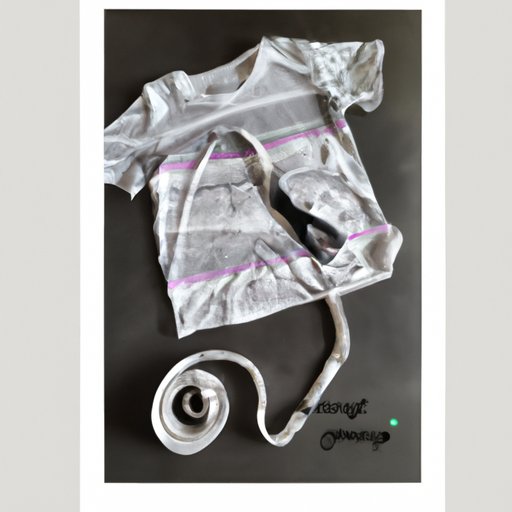
I. Introduction
Are you tired of spending money on boring, generic t-shirts? Do you want to express your creativity and personal style through your wardrobe? Making your own t-shirts at home is a great solution! Not only is it affordable and fun, but it also gives you complete control over the design, fit, and quality of your clothes.
In this article, we’ll provide a step-by-step guide to making t-shirts from scratch, as well as tips for customizing, designing, and repurposing old shirts. Whether you’re a beginner or an experienced seamstress, these techniques will help you create stylish and personalized t-shirts that reflect your unique personality and taste.
II. Step-by-Step Guide: Making Your Own T-Shirts at Home
Before you can start making t-shirts, you need to gather the necessary materials and tools. This includes fabric, a pattern, measuring tape, scissors, pins, a sewing machine, thread, and other sewing supplies. Once you have everything you need, follow these basic steps:
- Choose a fabric that is comfortable, durable, and suitable for your preferred style. Cotton jersey is a popular option, but you can also try blends or specialty fabrics like bamboo or hemp.
- Select a pattern that fits your size and design preferences. You can find patterns online or at fabric stores, or you can create your own by tracing a shirt that fits well.
- Measure yourself and adjust the pattern accordingly. This will ensure a flattering fit and prevent any errors during the sewing process.
- Cut the fabric according to the pattern, being careful to follow the grain line and any pattern markings. Use sharp scissors and trim any loose threads or excess fabric as you go.
- Sew the front and back pieces together at the shoulders, using a straight stitch and reinforcing the seams with a zigzag stitch or serger.
- Add sleeves, either by attaching them flat or in the round, depending on your pattern and preference.
Keep in mind that there are many variations and adjustments you can make to this basic process, depending on your skills and creativity. Experiment with different sleeve lengths, necklines, and hemlines, or play around with color-blocking and pattern-mixing to create unique designs.
III. 5 Affordable Tools and Materials for DIY T-Shirt Making
If you’re new to t-shirt making, it can be overwhelming to know what tools and materials you need to get started. Here are 5 essential items that are affordable, versatile, and beginner-friendly:
- Cotton jersey fabric: This is a soft, stretchy fabric that is easy to sew and comfortable to wear.
You may also want to invest in a good quality sewing machine if you plan to make multiple shirts or expand your sewing skills.
IV. Customize Your Wardrobe: Simple Ways to Design Your T-Shirts
Making your own t-shirts also gives you the opportunity to customize and personalize your clothes. Here are some easy ways to add your own unique touch to your shirts:
- Painting: Use fabric paint to create designs, patterns, or slogans on your shirts. You can use stencils, stamps, or freehand painting to get the desired effect.
- Stenciling: Create your own stencils using cardboard or plastic, then use fabric paint or spray paint to transfer the design onto your shirt.
- Dyeing: Experiment with tie-dye, ombre, or dip-dye techniques to add color and interest to plain white shirts.
Remember to choose a design and technique that suits your personal style and preferences. Have fun and experiment with different combinations until you find the perfect look!
V. Express Yourself: Using Iron-On Transfers to Create Unique T-Shirt Designs
Iron-on transfers are a popular and easy way to create custom designs for your t-shirts. Here’s how to do it:
- Choose a design: You can create your own using software like Photoshop or Illustrator, or you can find pre-made designs online or in craft stores.
Iron-on transfers can be used to create colorful, intricate designs or simple logos and lettering. They are also a great option for making t-shirts in bulk for events or promotions.
VI. From Scratch: Sewing Techniques for Crafting Your Own T-Shirts
If you want to take your t-shirt making skills to the next level, you can try sewing shirts from scratch using advanced techniques. Here’s what you’ll need:
Follow these steps to sew a t-shirt from scratch:
VII. Repurposing Old Clothes: Transforming Your Shirts into Stylish New Pieces
Finally, instead of buying new fabric, you can also repurpose old clothes and t-shirts to create unique and sustainable pieces. Here are some ideas to get you started:
Repurposing old clothes is not only eco-friendly, but it also allows you to experiment with different colors and patterns without spending money on new fabric.
VIII. Tips and Tricks for a Professional Look: How to Make T-Shirts That Last
Once you have the basic techniques down, there are a few tips and tricks you can use to ensure that your finished t-shirts look professional and last a long time:
IX. Conclusion
Making your own t-shirts at home is a fun, creative, and empowering way to customize your wardrobe and express your personal style. Whether you’re a novice or an expert seamstress, these tips and techniques will help you create unique and stylish shirts that you’ll love to wear. Don’t be afraid to experiment and try new things, and remember that practice makes perfect!
For more inspiration and resources, check out online sewing communities, blogs, and tutorials, and don’t hesitate to connect with other makers and enthusiasts who share your passion for DIY fashion.




